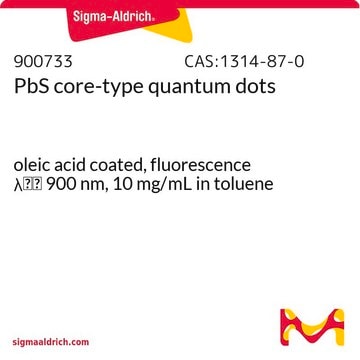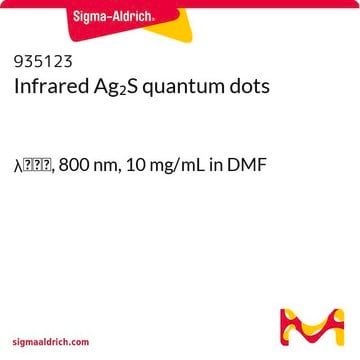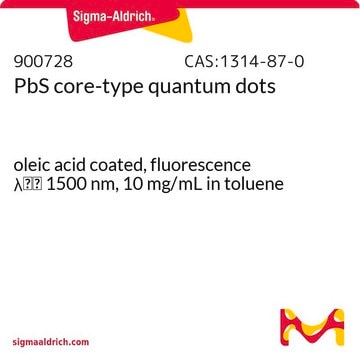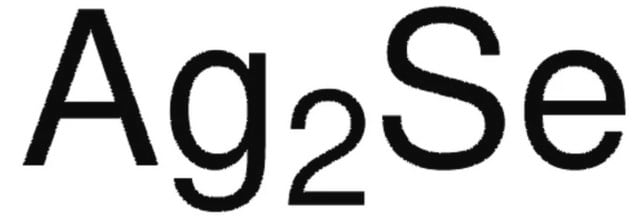The stokes shift for this material is expected to be around 30 nm. If the batch has an excitonic absorption peak at 1540 nm, the photoluminescence peak can be expected to be at 1570 nm. In terms of the photoluminescence quantum yield, a value between 25 to 30% PLQY is anticipated. Additionally, a photoluminescence (PL) spectra is provided, where the solid line represents the absorption spectra, and the dashed line represents the PL spectra.
Kluczowe dokumenty
925535
Infrared PbS quantum dots
λmax, 1550 nm, 100 mg/mL in toluene
Synonim(y):
12279 kropek kwantowych, Fluorescencyjne nanokryształy, QD, Typ rdzenia na bazie ołowiu
Wybierz wielkość
2150,00 zł
Wybierz wielkość
About This Item
2150,00 zł
Polecane produkty
Formularz
liquid
Poziom jakości
opakowanie
pkg of 1 mL
stężenie
100 mg/mL in toluene
wielkość cząstki
<10 nm (Nanoparticle)
λmaks.
≤120 nm (FWHM)
1550 nm
temp. przechowywania
2-8°C
ciąg SMILES
[Pb]=S
InChI
1S/Pb.S
Klucz InChI
XCAUINMIESBTBL-UHFFFAOYSA-N
Szukasz podobnych produktów? Odwiedź Przewodnik dotyczący porównywania produktów
Powiązane kategorie
Zastosowanie
Inne zastosowania tych materiałów obejmują wykrywanie światła i odległości (LIDAR), skanowanie laserowe 3D, ogniwa słoneczne, a także wykrywanie czasu lotu (ToF).
Informacje prawne
Hasło ostrzegawcze
Danger
Zwroty wskazujące rodzaj zagrożenia
Zwroty wskazujące środki ostrożności
Klasyfikacja zagrożeń
Aquatic Chronic 2 - Asp. Tox. 1 - Flam. Liq. 2 - Repr. 1A - Skin Irrit. 2 - STOT RE 2 - STOT RE 2 Inhalation - STOT SE 3
Organy docelowe
Central nervous system
Kod klasy składowania
3 - Flammable liquids
Klasa zagrożenia wodnego (WGK)
WGK 3
Temperatura zapłonu (°F)
39.2 °F
Temperatura zapłonu (°C)
4 °C
Wykazy regulacyjne
Wykazy regulacyjne dotyczą głównie produktów chemicznych. Można w nich podawać ograniczoną liczbę informacji na temat produktów niechemicznych. Brak wpisu oznacza, że żaden ze składników nie znajduje się w wykazie. Użytkownik odpowiada za zagwarantowanie bezpiecznego i zgodnego z prawem stosowania produktu.
Wybierz jedną z najnowszych wersji:
Certyfikaty analizy (CoA)
Nie widzisz odpowiedniej wersji?
Jeśli potrzebujesz konkretnej wersji, możesz wyszukać konkretny certyfikat według numeru partii lub serii.
Masz już ten produkt?
Dokumenty związane z niedawno zakupionymi produktami zostały zamieszczone w Bibliotece dokumentów.
Produkty
Infrared lead sulfide (PbS)-based quantum dots absorb and emit light across the near-infrared and short-wave infrared wavelengths. Our PbS quantum dots have well-characterized optoelectronic properties and surface chemistry suitable for integration into photodetectors, photovoltaics, and infrared LEDs.
-
What is the emission wavelength of 925535? Additionally, what is the quantum yield?
1 answer-
Helpful?
-
Active Filters
Nasz zespół naukowców ma doświadczenie we wszystkich obszarach badań, w tym w naukach przyrodniczych, materiałoznawstwie, syntezie chemicznej, chromatografii, analityce i wielu innych dziedzinach.
Skontaktuj się z zespołem ds. pomocy technicznej










